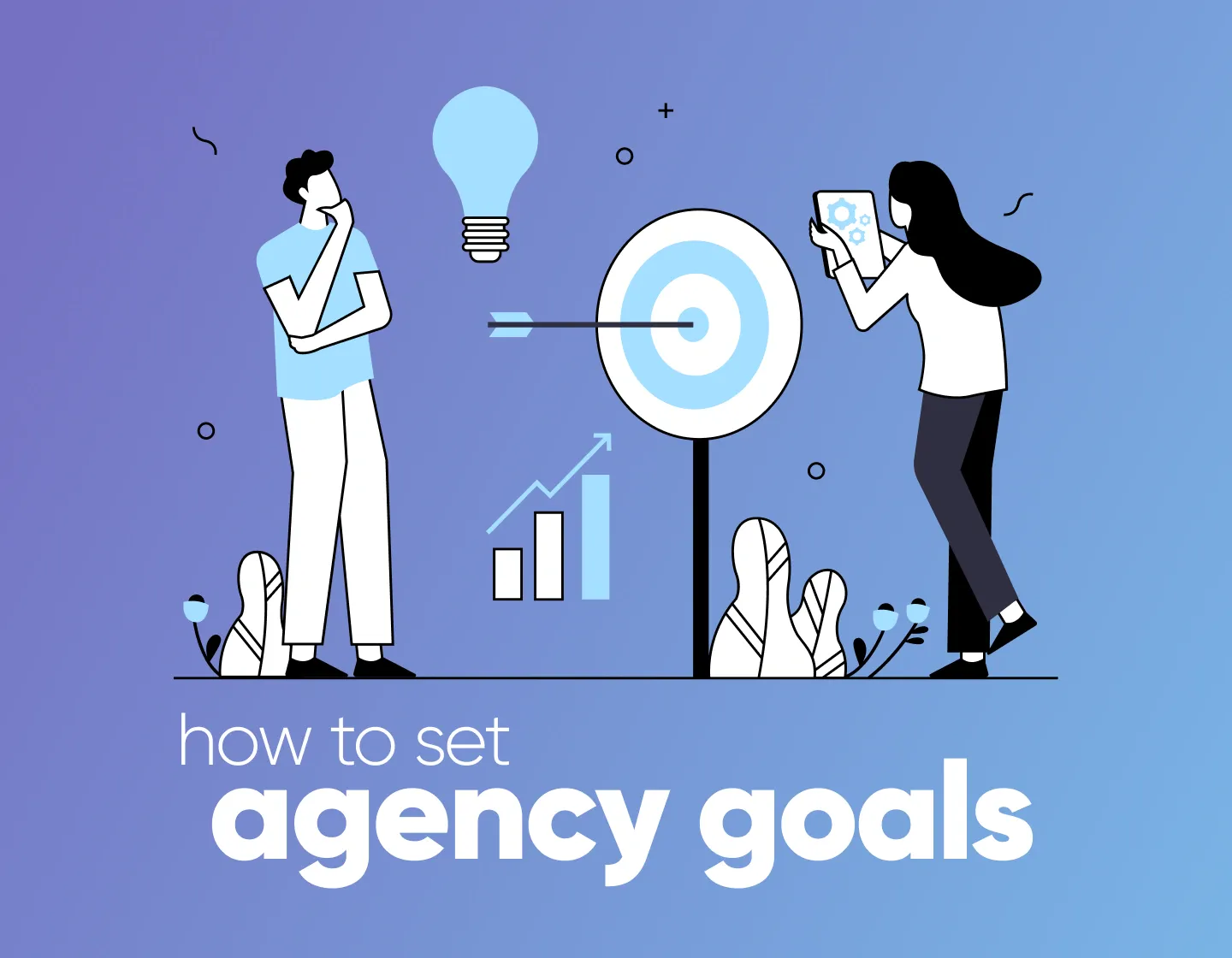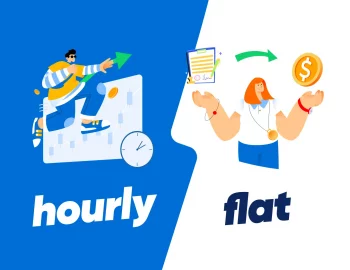To set inspiring goals for your agency sounds great in theory, but it often takes a back seat when you have more important things to do, like achieving client goals, managing multiple projects, creative direction, and finances, all while probably fixing the Wi-Fi again.
Still, you know you need something more specific, measurable, and empowering than just “let’s grow” or “get better clients.” You want direction and inspiration. You want clarity without crushing your creative spark.
The good news? Setting goals doesn’t have to be overwhelming or tedious. In fact, it can be energizing, especially when it’s designed for how creative agencies actually work. So, come dive with me into how to set agency goals that feel aligned, actionable, and honestly doable.
1. Why it’s important to set agency goals
Here’s the thing – when you have a small agency, it’s easy to think you can skip the goal-setting stuff. You’re agile! You talk all the time! Everyone knows what’s going on…right?
Well, kind of. Until the work gets busy (it always does), and suddenly your team’s running in five different directions, making decisions based on vibes instead of vision. That’s when things start to feel chaotic. The spark’s still there, but it’s buried under urgent client requests, unclear priorities, and endless “Are we even making progress?” moments.
That’s exactly where goals come in – not as some corporate checklist, but as a creative compass.
When you set the right agency goals, you:
- Give your team a shared direction (so they’re not guessing what matters most)
- Make better, faster decisions (because now you have a filter)
- Track progress beyond just client wins or revenue growth
- Catch burnout early by seeing when you’re doing too much with too little
- Build the agency you’ve been dreaming about, one intentional step at a time
So no, goals aren’t just for big agencies with account managers and OKRs (Objective and Key Results). They’re for tight-knit, passionate teams (like yours) – especially if you’re growing, evolving, or just trying to stay sane while doing excellent work.
2. The 4-Part goal framework for creative studios
If traditional goal-setting makes your eye twitch, you’re not alone. Most frameworks feel built for stuffy boardrooms, not nimble creative teams. That’s why I’m keeping this refreshingly simple. No jargon. No fluff. Just four parts that help you turn “we want to grow” into something real and doable. Let’s see:
2.1. Start with the right vision
Before you write a single goal, zoom out and try to answer these questions: Where do you want your agency to be in 1–3 years? What kind of work do you want to be known for? Who do you want to serve? How do you want your team to feel working there?
Think big-picture – but not blurry. This isn’t about wordy agency mission statements; it’s about defining what success looks like for you. Your goals should ladder up to this vision, like stepping stones across a river.
Example:
“In 3 years, we want to be the go-to studio for wellness brands, with a solid team culture, 60% recurring revenue, and space to pursue passion projects each quarter.”
2.2. Define quarterly or yearly themes
Now, bring that vision down to Earth. Choose 2-3 focus areas for the next quarter or year – these are your “themes.” They help you narrow in on what’s most important right now.
Think:
- “Streamline our operations.”
- “Level up client experience.”
- “Position ourselves as creative thought leaders.”
Themes aren’t goals themselves – they give your goals purpose and direction, while helping your team stay aligned and grounded.
2.3. Set SMART-ish goals for your agency
Yes, I said it – SMART goals. But don’t worry, we’re not getting corporate about it. The point is to get specific enough that you can actually measure progress without turning your studio into a spreadsheet factory.
A good creative agency goal should be:
- Specific enough that you know when you’ve achieved it
- Flexible enough that it doesn’t suppress exploration
- Tied to a clear theme (so it serves your bigger picture)
Examples:
- Financial goal: “Increase average project value by 20% by Q4”
- Operational goal: “Create a repeatable onboarding system for new clients by the end of the quarter.”
- Creative goal: “Launch one passion project this year that pushes our aesthetic boundaries.”
- Visibility goal: “Grow newsletter list to 3,000 with monthly emails and lead magnets”
2.4. Use mini-metrics + milestones
This is where many agencies get stuck. You set a goal… and then forget it by Week 3. The fix? Break goals into mini-metrics and milestones.
Instead of just “Launch a new service,” try:
- Map the offer → Draft pricing → Build landing page → Soft launch to VIP clients → Full rollout
- Track small indicators: number of inquiries, feedback from test clients, landing page conversion
These little wins build momentum – and help you adjust if things go sideways (because let’s be real, they sometimes do).
You don’t need dozens of goals. Just a few really good ones that are rooted in vision, focused by themes, and broken down into small, measurable steps. Simple. Strategic. Actually doable.
3. Involve the team
Here’s a little secret: the fastest way to make your team not care about goals? Set them in isolation, announce them in Slack, and hope they stick. Creative people are wired for ownership. They want to contribute, question, shape. So when you bring your team into the goal-setting process early, you don’t just get better new ideas – you get way more buy-in.
This doesn’t mean you need to host a five-hour offsite with color-coded worksheets (unless you want to, in which case, go off). It just means giving your team space to share what they see, feel, and want to improve. So, how to co-create attainable goals with your team?
3.1. Start with a gut-check session
Ask simple questions like:
- What’s working really well right now?
- What feels frustrating or inefficient?
- Where do we see opportunities to grow or experiment?
And, do it casually – you’re collecting insights, not making final decisions yet.
3.2. Share the big-picture vision
If you already have a 1-3 year vision (from the last section – look at you go!), share it. If not, sketch it out with the team. Establish a culture of open communication – talk about where you want to be and ask what they think needs to happen to get there.
3.3. Shape themes and set goals together
Instead of dropping fully-defined goals on everyone, try bringing a few themes to the table and letting the team build on them.
For example:
“One of our themes is improving client experience. What do you think would actually change things in this direction?”
This invites collaboration without total chaos – you’re guiding, not dictating.
3.4. Assign mini-goals and role-based metrics
Not every team member needs to care about agency-wide revenue, but they do want to know how their work contributes.
So, translate goals into mini-goals by role:
- Designers → streamline the file delivery process
- PMs → reduce turnaround time for proposals
- Copywriters → increase blog engagement or email open rates
Now they’re not just your own goals – they’re our goals.
Key takeaway? Team-aligned goals = stronger execution + happier humans.
You get accountability without micromanaging. Clarity without crushing autonomy. And when people see their fingerprints on the plan, they’re way more likely to show up with energy and purpose.
4. Keep goals visible (and actually use them)
If your agency’s goals live in a doc no one opens after week one, they’re not goals – they’re ghosts. And haunted studios don’t scale. The solution? Make your goals so visible and integrated into your workflow that they become part of how your team thinks, plans, and celebrates progress.
4.1. Build a living goals dashboard
With the project management software your business already uses, create a simple visual board that shows:
- Each theme or focus area
- The top 3-5 active goals
- Owner(s), milestones, and due dates
- Progress status (use color coding, emojis, or a friendly traffic light system, whatever works)
This isn’t about micromanaging – it’s about keeping everyone oriented and on the same page. Bonus: It’s way easier to celebrate wins when you can see them building up over time.
4.2. Weave goals into weekly or monthly rituals
You don’t need endless check-ins. Just a lightweight rhythm to keep goals top-of-mind and ensure alignment:
- Monday stand-ups: “What’s one thing we’re doing this week that supports a current goal?”
- Monthly team reviews: “Which goals are on track, which need adjusting, and what’s blocking us?”
- Quarterly throwbacks: Reflect on what worked, what didn’t, and set new, clear goals together.
This helps achieve success as the team feels ownership, not just accountability.
4.3. Celebrate the small wins along the way
Don’t wait until the finish line to recognize progress. Every approved wireframe, published article, or client testimonial that ladders up to a goal is a win worth pausing for.
Celebrate those in your Slack channel, team meetings, or project management tools. You’re reinforcing the behavior you want to see more of – and thus reminding your team that their effort matters.
4.4. Adjust without shame
Goals aren’t carved in stone. Sometimes timelines shift. Sometimes a goal turns out to be the wrong focus. That’s not failure – it’s feedback.
Make space to update expectations or retire goals without guilt. The point is growth, not perfection.
Think of your agency goals like a creative brief, a north star for your agency. The more visible and usable they are, the more aligned and energized your team becomes. And the more you treat them like a living part of your process, not a one-and-done task, the more they’ll actually work.
5. A deeper dive – the SMART framework to make creative goals work
Since we touched on SMART goals earlier, I’ll dive a little bit deeper into this goal-setting process for those of you not familiar with it. You’ve probably heard of SMART goals – they’re classic for a reason. But while the framework is well-known, it can feel stiff unless you adapt it for creative agency work.
Firstly, not every business tool is built with creative studios in mind. But with a little tweaking, the SMART method can help you turn loose ideas into achievable goals that are actually motivating, trackable, and doable – without killing the creative vibe.
Here’s how the SMART framework breaks down, and how to make it work for your creative agency:
S = Specific
Define what you’re actually trying to do. “Improve our agency website” is vague, and you can easily lose sight of such a set goal. “Redesign our homepage to better reflect our brand and boost lead conversions” is clear. The more specific and focused, the more actionable.
M = Measurable
What does progress look like? Pick a number, a milestone, or a clear yes/no outcome. If it’s a creative goal, you might track an audience’s social media engagement, completion, or even internal satisfaction metrics. The key is knowing when you’ve made progress.
A = Achievable
Aim high, but keep it real. You’re a team of six, not sixty. Is this goal challenging enough to inspire action, but realistic enough not to cause burnout? Consider bandwidth, resources, and current priorities. Realistic goals are attainable goals.
R = Relevant
Every goal should ladder up to a broader agency theme or shared vision, to an ultimate destination. Does this set goal help move the agency forward? Does it tie into something your team cares about – like positioning, revenue, or creative fulfillment? To get tangible results, you need to set goals that are relevant.
T = Time-bound
Goals without deadlines become wishful thinking, a “someday” dream, and those are easy to ignore. A specific timeframe gives shape to the goal and a reason to prioritize it. Whether it’s “by the end of Q3” or “in the next 6 weeks,” putting a time cap on it brings momentum.
Example SMART goal for a creative agency:
“Increase average project value by 20% by Q4 by introducing a new ‘brand + website’ bundle offer.”
To wrap it up, SMART goals are especially helpful for the kinds of strategic goals and decisions agency leaders need to make, like increasing revenue, improving processes, or launching a new service offering. The trick is not to treat the framework like a checklist but like a lens to clarify your thinking.
And remember: goal-setting isn’t just about hitting targets – it’s about creating momentum. When your entire team knows (and sees) where you’re going and how to help get there, they don’t just do more work – they do the right work, focused, together, with purpose.
Bottom line? Your agency goals don’t need to be perfect – just intentional
Here’s the truth: start small and stay consistent – you don’t need to set perfect agency goals to start seeing real progress. You just need a starting point, a shared direction, and a rhythm that works for your business.
You’re establishing a practice, not a one-off exercise. With every round of goal-setting, you’re teaching your team how to think bigger, work smarter, and measure what truly matters.
The win isn’t in perfection – it’s in consistency.
Now, if you’re ready to learn more about how to achieve business and project success and fuel up your agency’s growth, check out these pieces:





